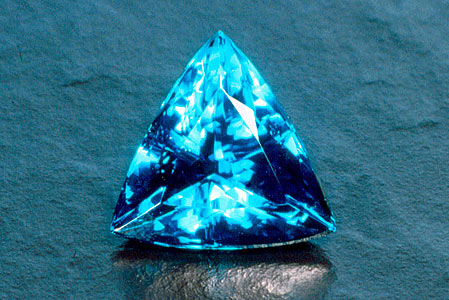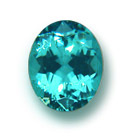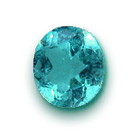 FREE SHIPPING on US orders over $150. Need help? Contact Us
FREE SHIPPING on US orders over $150. Need help? Contact Us Genuine Paraiba Tourmaline Gemstone

Paraiba (Pronunciation: \'pa-rə-"ē-bə\) Tourmaline
Small, rare and very valuable are those copper-containing Tourmalines mined at the Mina da Bathalha in the Brasilian state of Paraiba. The vivid turquoise blue to green colours are not shown by any other gemstone in the world, The exclusive uniqueness of the legendary occurrence make these rare gemstones real treasures.
"Paraiba" – the word as such holds a special charm and attraction for gemstone lovers, after all, this is the denomination of a gemstone showing an exceptional, almost electric blue to green shades. It was discovered not long ago, to be precise: in the year 1987 The world owes this sensational find to an individual man and his unshakeable belief: to Heitor Dimas Barbosa. Never tiring, he had been digging with his helpers for years in the pegmatite layers of a small mountain range in the state of Paraiba in Brazil.
Heitor Dimas Barbosa was not just simply a gemstone prospector, and, first of all: he was not searching for something known. He was deeply convinced that somewhere under the famous "Paraiba" hill there was hidden something "completely different" – and in the end his vision proved to be right. As early as 1981 he had started with the first preliminary steps for excavations in old abandoned mines. Hole after hole was driven into the hard soil – but in vain. However, all of a sudden, five and a half years after the first digging, in the labyrinth of shafts and passages there showed the first hints of a Tourmaline occurrence. Finally in autumn 1989 a handful of finest Tourmaline crystals was brought to the light of day from one of the many dark passages. These crystals showed colours which had never been dreamt of before. Unfortunately the "Father of the Paraiba Tourmaline” had to recover from an illness at this time, and could not be there at the mines. The rough crystals were sold without him ever setting eyes on them. After the find had become publicly known, the most adventurous stories happened at the mines. For a period of another five years the relatively small mountain range measuring only 400 m in length, 200 m in width and 65 m in height, had been turned into a virtual honeycomb of shafts and tunnels, and the mountain had almost been levelled. But in vain. And by now, nobody expects another find any more.

Copper makes the difference
Brazil is the classical Tourmaline country. This multi-coloured gemstone family shows practically all the colours of the rainbow. However, a brilliant turquoise shade had always been missing for a long time – until the valuable find was made at Paraiba.
Usually it is traces of iron, manganese, chromium and vanadium which are responsible for giving Tourmalines their many beautiful colours. But this is quite different for the rare Paraiba Tourmaline: it owes its spectacular colour to copper, an element which had not shown up in Tourmalines before. There is a clear part of its weight made up by copper. In addition, it often also contains manganese as scientists have found out.
The combination of these two elements causes a wide range of beautiful and fascinating colours in Paraiba Tourmalines: emerald green, turquoise to sky-blue, sapphire blue, indigo blue, dark purple to red purple. Certain mixtures of copper and manganese may also result in pale grey to purplish-blue colours. A high concentration of copper is responsible for the much coveted brilliant blues, turquoises and greens, while purples and reds are caused by manganese. By heating the stones, experienced cutters are able to eliminate the red traces, so that only the bright copper colour will show.
The exceptionally vivid character of Paraiba Tourmalines , however, can only be appreciated after the stone has been cut. When it has been faceted, a unique fire and brilliance is displayed, which makes the stone seem to glow and shine from within even when there is little light. Therefore the colour is often characterised as "electric" or "neon". Fresh and full of energy is the charm and attraction of these treasures of Nature. A Paraiba Tourmaline in "swimming-pool blue” is the epitome of vividness and easy to discern even for an amateur.

Paraiba Tourmalines are almost always very small, as the beautiful copper-containing Tourmaline crystals mined in the "fine hill” at Paraiba were almost exclusively fragments and splinters. Larger, unfragmented rough stones weighing over 5 gram were rare, and only very few achieved weights of more than 20 gram. Therefore you will hardly find a larger Paraiba Tourmaline at a jeweller’s or gemstone trader’s, besides, only a select few of these will even carry this kind of stone.
The beauty and vividness of colour shown by Paraiba Tourmalines gave reason to enthusiasm for the gemstone world . Within only a short period considerable popularity had been gained, and these stones today belong to the most coveted and most expensive stones in the world. Prices continue to go up, and in the meantime they have reached such regions which used to be considered utopian for Tourmalines in the past. Five digit carat prices are asked and paid for fine, larger Paraiba Tourmalines. The market almost completely and immediately soaked up the limited offer of rough stones. This is easy to understand, for here Nature created a gemstone which is second to none concerning colour, brilliance and luminosity. And without Heitor Dimas Barbosa and his vision to find "something completely different", it probably would not exist on the market at all.
Is Paraiba situated in Africa?
The Paraiba story should actually end here. But Nature always holds some surprises for all of us. The story was in fact continued in the beginning of 2001, but the setting was in quite another part of the world. Suddenly in 2001 there appeared brilliant bluish-green Tourmalines from Nigeria on the market, similar to those which had been known from Paraiba. It was a perfect scoop: just like the Paraiba Tourmalines these stones show their real beauty after being heated carefully. In general their colours seem a little lighter, but the difference is hardly discernible for somebody who is not an expert. Also the scientists find it difficult to come up with characteristic features which differ between Tourmalines from Nigeria and Paraiba respectively. The copper-containing mines in Nigeria explain the similarity in chemical components. Both specimen owe their colour to copper and manganese. How is that possible? Has Paraiba moved to Africa? Well, of course not. But this example of a valuable gemstone clearly illustrates the phenomenon of the continental drift. We only have to consult a card and compare the silhouettes of the African and the South American continent. If we project the coastline of South America onto Africa, both elements fit like in a jigsaw puzzle. And Nigeria would then be directly linked to north-east Brazil. Probably the brilliant and bright copper Tourmalines from Nigeria were created under the same conditions as the Paraiba ones, before the continents drifted apart. Is that the explanation why they are so difficult to tell apart? This will remain one of the mysteries and secrets in the world of gemstones. And gemstone lovers will be happy that African Tourmalines in vivid green-blue offer an alternative on the market to the legendary Paraiba Tourmalines.



